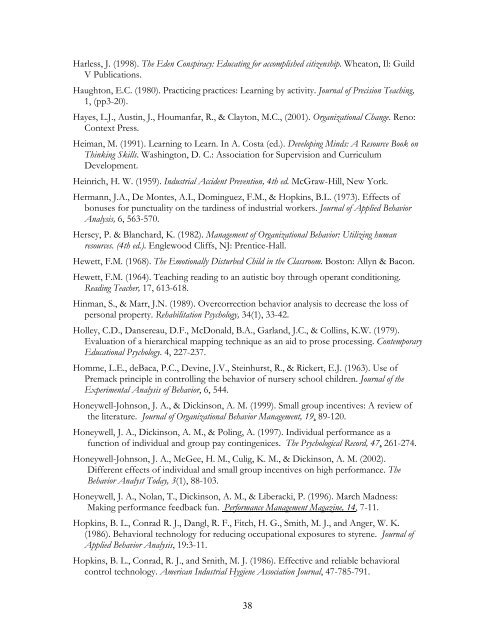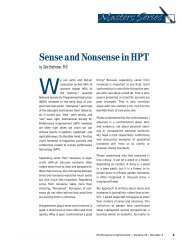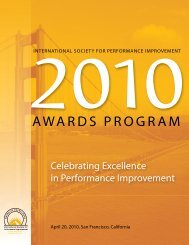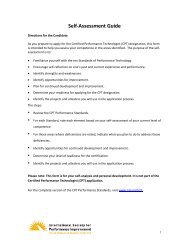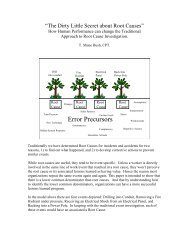Yes We Can! - International Society for Performance Improvement
Yes We Can! - International Society for Performance Improvement
Yes We Can! - International Society for Performance Improvement
You also want an ePaper? Increase the reach of your titles
YUMPU automatically turns print PDFs into web optimized ePapers that Google loves.
Harless, J. (1998). The Eden Conspiracy: Educating <strong>for</strong> accomplished citizenship. Wheaton, Il: Guild<br />
V Publications.<br />
Haughton, E.C. (1980). Practicing practices: Learning by activity. Journal of Precision Teaching,<br />
1, (pp3-20).<br />
Hayes, L.J., Austin, J., Houmanfar, R., & Clayton, M.C., (2001). Organizational Change. Reno:<br />
Context Press.<br />
Heiman, M. (1991). Learning to Learn. In A. Costa (ed.). Developing Minds: A Resource Book on<br />
Thinking Skills. Washington, D. C.: Association <strong>for</strong> Supervision and Curriculum<br />
Development.<br />
Heinrich, H. W. (1959). Industrial Accident Prevention, 4th ed. McGraw-Hill, New York.<br />
Hermann, J.A., De Montes, A.I., Dominguez, F.M., & Hopkins, B.L. (1973). Effects of<br />
bonuses <strong>for</strong> punctuality on the tardiness of industrial workers. Journal of Applied Behavior<br />
Analysis, 6, 563-570.<br />
Hersey, P. & Blanchard, K. (1982). Management of Organizational Behavior: Utilizing human<br />
resources. (4th ed.). Englewood Cliffs, NJ: Prentice-Hall.<br />
Hewett, F.M. (1968). The Emotionally Disturbed Child in the Classroom. Boston: Allyn & Bacon.<br />
Hewett, F.M. (1964). Teaching reading to an autistic boy through operant conditioning.<br />
Reading Teacher, 17, 613-618.<br />
Hinman, S., & Marr, J.N. (1989). Overcorrection behavior analysis to decrease the loss of<br />
personal property. Rehabilitation Psychology, 34(1), 33-42.<br />
Holley, C.D., Dansereau, D.F., McDonald, B.A., Garland, J.C., & Collins, K.W. (1979).<br />
Evaluation of a hierarchical mapping technique as an aid to prose processing. Contemporary<br />
Educational Psychology. 4, 227-237.<br />
Homme, L.E., deBaca, P.C., Devine, J.V., Steinhurst, R., & Rickert, E.J. (1963). Use of<br />
Premack principle in controlling the behavior of nursery school children. Journal of the<br />
Experimental Analysis of Behavior, 6, 544.<br />
Honeywell-Johnson, J. A., & Dickinson, A. M. (1999). Small group incentives: A review of<br />
the literature. Journal of Organizational Behavior Management, 19, 89-120.<br />
Honeywell, J. A., Dickinson, A. M., & Poling, A. (1997). Individual per<strong>for</strong>mance as a<br />
function of individual and group pay contingenices. The Psychological Record, 47, 261-274.<br />
Honeywell-Johnson, J. A., McGee, H. M., Culig, K. M., & Dickinson, A. M. (2002).<br />
Different effects of individual and small group incentives on high per<strong>for</strong>mance. The<br />
Behavior Analyst Today, 3(1), 88-103.<br />
Honeywell, J. A., Nolan, T., Dickinson, A. M., & Liberacki, P. (1996). March Madness:<br />
Making per<strong>for</strong>mance feedback fun. Per<strong>for</strong>mance Management Magazine, 14, 7-11.<br />
Hopkins, B. L., Conrad R. J., Dangl, R. F., Fitch, H. G., Smith, M. J., and Anger, W. K.<br />
(1986). Behavioral technology <strong>for</strong> reducing occupational exposures to styrene. Journal of<br />
Applied Behavior Analysis, 19:3-11.<br />
Hopkins, B. L., Conrad, R. J., and Srnith, M. J. (1986). Effective and reliable behavioral<br />
control technology. American Industrial Hygiene Association Journal, 47-785-791.<br />
38


